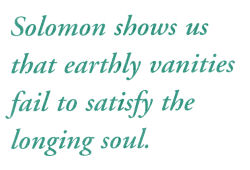INTRODUCTION
Ecclesiastes:
The Painful Perspective
 Unlike other books in
Scripture, which often begin with a strong affirmation about God ("The
Word of the Lord to . . ."), Ecclesiastes commences with a cry about
the meaninglessness of life. "Vanity of vanities . . . all is vanity."
This opening sounds more like modern secular writers than a prophet of
Yahweh. Nevertheless, as Seventh-day Adventist Christians, we believe
that Ecclesiastes was placed in the canon of Scripture because God has
in it a message for us. Unlike other books in
Scripture, which often begin with a strong affirmation about God ("The
Word of the Lord to . . ."), Ecclesiastes commences with a cry about
the meaninglessness of life. "Vanity of vanities . . . all is vanity."
This opening sounds more like modern secular writers than a prophet of
Yahweh. Nevertheless, as Seventh-day Adventist Christians, we believe
that Ecclesiastes was placed in the canon of Scripture because God has
in it a message for us.
Nothing, though, about this book, its message,
or even its origin, has avoided controversy. For instance, many
scholars claim that the author—whoever it was—wasn't King Solomon. Of
course, these are often the same scholars who claim that Daniel was
written in the second century B.C. or that Moses never wrote Genesis,
so we can dismiss them out of hand. We are, instead, proceeding on the
assumption that Solomon was the writer, an assumption based on
Christian and Jewish tradition, on internal evidence inside the book
that points to Solomon as the author, as well as on Ellen White's
statements that "the book of Ecclesiastes was written by Solomon in his
old age, after he had fully proved that all the pleasures earth is able
to give are empty and unsatisfying. He there shows how impossible it is
for the vanities of the world to meet the longings of the soul. His
conclusion is that it is wisdom to enjoy with gratitude the good gifts
of God, and to do right; for all our works will be brought into
judgment."—Ellen G. White Comments, The SDA Bible Commentary,
vol. 3, p. 1164.
Yet, anyone who has ever studied Ecclesiastes
knows its challenges. Some texts are obscure, their meanings difficult
to discern; sometimes, though, the greatest challenge comes from not
when we don't know what the texts mean but when we do. Thus, a few
simple points of interpretation will greatly help us as we undertake
this study.
To begin, Solomon was writing at the end of his
life, a life full of bitterness and anger at himself and his apostasy.
What's unique about the book is that in some places Solomon is writing
from the perspective of someone alienated from God. Like modern
authors, he's giving us thoughts that flow directly from his head. We
see the world as it appears through his eyes.
In such places it is well to heed the words of
The SDA Bible Commentary: "Those portions of Ecclesiastes that relate
the experience and reasoning of [Solomon's] years of apostasy are not
to be taken as representing the mind and will of the Spirit.
Nevertheless, they are an inspired record of what he actually thought
and did during that time (see Prophets and Kings, p. 79), and that
record constitutes a sober warning against the wrong kind of thought
and action. . . . Passages such as these should not be wrested from
their context and made to teach some supposed truth that Inspiration
never intended them to teach."—The SDA Bible Commentary, vol.
3, p. 1060.
How do we know, though, which are those
passages? This question leads to the second important principle for
studying Ecclesiastes: We must read it in the context of the whole
Scripture. What is Scripture's basic message about life, death, and our
purpose in life? When a text of Ecclesiastes seems to conflict with the
grand themes of the Bible, we can be sure it's Solomon reflecting on
life froth the perspective of alienation and separation from the Lord.
These texts, of course, shouldn't be used as the basis of theology;
they should be used, instead, as practical warnings about what happens
when we lose sight of God, our Creator and Redeemer.
In the end, that's what this book is really
about: It's God showing us how cynical, bitter, and empty life is apart
from the knowledge of Him. It's our hope that we can learn this lesson
from our study of Ecclesiastes, in contrast to how its author, Solomon,
had to learn it—the hard way.
Contents:
(all lessons may not be posted)
Giardina Sabbath
School Study Helps
Jerry Giardina of
Pecos, Texas, assisted by his wife, Cheryl, prepares a series of helps
to accompany the Sabbath School lesson. He includes all related
scripture and most EGW quotations. Jerry has chosen the "New King James
Version" of the scriptures this quarter. It is used with permission.
The study helps are provided in three wordprocessing versions
Wordperfect;
Microsoft Word;
RTF for our
MAC friends (this is now a zip file); and HTML
(Web Pages).
Last updated on November
12, 2006
Editorial
Office: 12501 Old Columbia Pike, Silver Spring, MD 20904.
Principal Contributor: James W. Zackrison
Editor: Clifford R. Goldstein
Associate Editor: Lyndelle Brower Chiomenti
Publication Manager: Soraya Homayouni Parish
Editorial Assistant: Larie S. Gray
Pacific Press Coordinator: Paul A. Hey
Art and Design: Lars Justinen
Concept Design: Dever Design
Copyright
© 2007 by the Office of the Adult Bible Study Guide,
General Conference of Seventh-day Adventist. All Rights Reserved.
SSNET Web Site Home page
Directory of Sabbath School Bible
Study materials
Archive of previous Adult
Sabbath School Bible Study Guides
Prepared for the Internet
by the SSNET Web
Team.
|